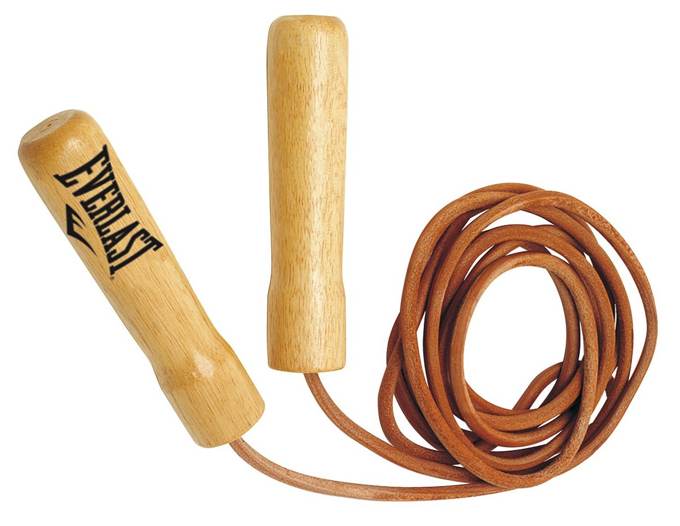Everlast Leather Jump Rope

Jump rope has ball bearings in handles
I have been jumping rope for about 2 years intermittently, but in the past 5 months it has become my regular go-to for daily exercise and conditioning. Around that time I moved from the mountains to the city. Before moving, I would run from 30 – 50 miles a week on trails, and the transition out of that lifestyle was a bit hard on mind and body at first.
I took up the jump rope in a more devoted way as a result of my move to the city. Previously, I would use it only on my off-days from trail running to stay limber and conditioned for longer runs. I’m no expert on training, but in this application, it worked like a charm for me. The muscles for running steep trails were kept in shape, and it was a fun challenge to see how long I could jump continuously.
Now that I run only on weekends, my jump rope has been a more constant companion, and my relationship to it has changed. It is now my primary form of exercise (along with isometric exercises) and I am happy to recommend it, especially to those who find it difficult to devote adequate time and effort to staying fit on a daily basis. I use two different kinds: a generic brand weighted-handle plastic cord jump rope, and an Everlast leather jump rope. I’ve found that they have different benefits.
The weighted-handle rope is very fast, and gets the blood pumping very quickly. It requires less movement of the arms to keep it moving, and consequently is what I use more for simple cardiovascular exercise. The plastic cord is also heavier than the leather, and keeps its “U” shape while skipping with much less effort. I use this rope when I get home from work in the evening before eating dinner.
Like many people, I very often feel drained after work (I am an elementary school teacher). Even just a quick 20-minute session is rejuvenating to the mind and healthful for the body. For me, it also provides a crucial transition between work and home.
The Everlast leather jump rope is a bit different, and I recommend it for a few reasons. In my experience, no jump rope will last longer than a few months of frequent use, especially if you’re jumping on abrasive surfaces like asphalt or concrete. I recommend this rope because, frankly, it’s inexpensive. At 15-20 bucks, it won’t break your heart when the leather snaps (and honestly it feels pretty heroic when you wear through a rope). Additionally, my experience with the leather rope is that it provides a somewhat more comprehensive exercise, requiring more upper body strength and coordination to keep it moving at the correct speed and with the correct tension. Also, significantly for me, the leather rope can be taken through airport security in a carry-on bag. It is compact (it can be tucked inside your shoes if need be) and very portable and makes exercising while traveling easy. Finally, jumping rope is really fun. It is challenging at first, but improvement is rapid, and there is no upper limit to its difficulty: you just keep jumping more. In the past, the problem for me has been that exercise outside of the forest can be boring and, especially after a hard day, I become psychologically opposed to it. Nowadays, I find myself eagerly looking forward to coming home and clearing my head with several hundred jumps before eating dinner and preparing my lessons for the next day. Because they’re inexpensive, I keep one in my day bag or car and one at home so I can jump wherever I happen to end up (and have a spare just in case I destroy one). Every sport supply shop I’ve gone into has carried the Everlast leather jump rope, but like everything else procurable by money, it can also be had on Amazon.
08/9/16Everlast Leather Non-Weighted Jump Rope ($28)









